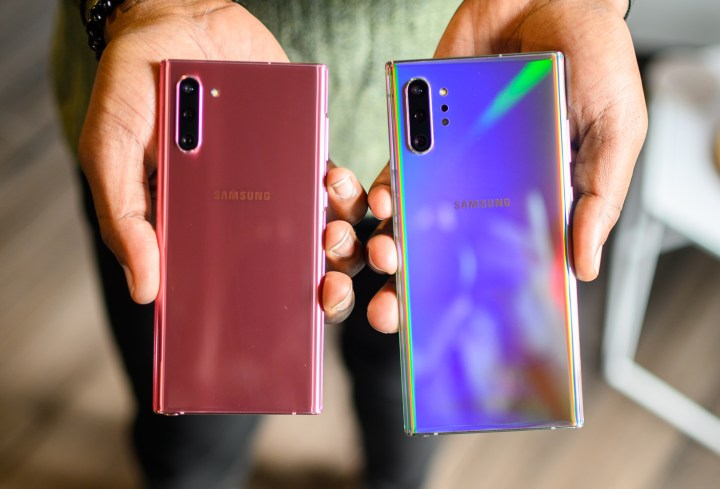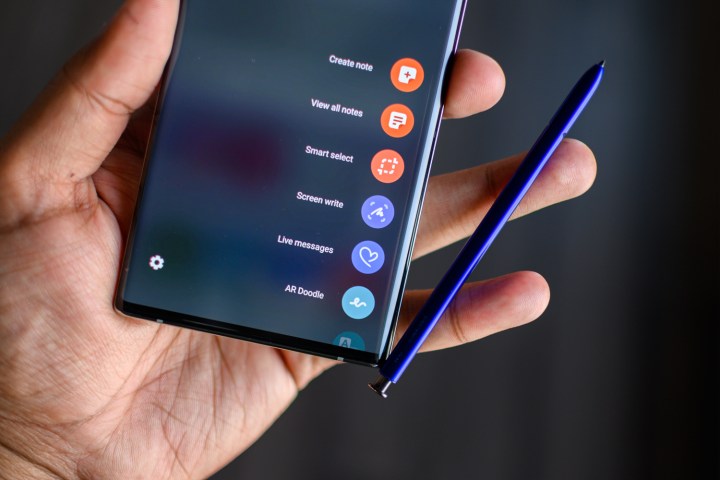
Galaxy Note devotees, your loyalty has been rewarded. After sticking with the range, even in the face of adversity, Samsung has delivered to you the ultimate Note phone yet — the Galaxy Note 10. It has taken a while, but with the Note 10, the series has regained its identity after languishing as just another big-screen smartphone in a sea of copycats.
Digital Trends sat down with Paul Scott, head of product management for Samsung, for a chat about how the Note series has evolved since the Galaxy Note 9. There’s a serious master plan behind the new range. The stunning new look of the phone has been applied to more than one model, and if you weren’t a Note fan before, prepare to be quickly converted.
Check out our Galaxy Note 10 and Galaxy Note 10 Plus hands-on reviews for our full impressions.
Iconic design
For the first time in several generations, we are seeing a Note smartphone that’s distinctly and unmistakably a Note. It won’t be dismissed after a casual glance as an S10 Plus. It has had a visit to the tailors, and come out wearing a made-to-measure suit that will turn heads.
“Everything we’re doing is trying to make a more iconic design for the Note,” Scott told me. “On the back, normally we would have a horizontal lens, but we have made it vertical. On the right-hand side, the buttons have gone and we have made it completely flush. We’ve just got the two buttons on the left-hand side. The pin-hole lens has been centralized for a super streamlined look. From a design perspective, it’s a complete overhaul versus the Note 9.”

The first time you pick it up, you’ll be shocked at the low weight of the Note 10. It’s so light, you’ll think the battery has been left out. The edges curve around the side of the phone, meeting tiny barely-there slivers of the bezel, and the centrally mounted pin-hole selfie camera balances the look perfectly.
“We are continually coming up with fresh ideas,” Scott said on the genesis of the new design. “We wanted it to be as streamlined and slick as possible. The device that represents the very best of technology has to look the very best as well. There was a lot of research and design that went into it, and a lot of big decisions as well.”
The right decisions
How big were these decisions? The Bixby button has sensibly been removed, increasing the streamlined look and resulting in fewer annoyances for owners, and the virtual assistant is now called up using the customizable power button. Samsung chose to remove the 3.5mm headphone jack so it could slim the Note 10’s Gorilla Glass 6-encased body down so drastically.
But it’s the number of devices now in the line-up that’s the biggest alteration. For the first time, there will be more than just one Note model released. You can choose between the Note 10, the Note 10 Plus, and the Note 10 5G.
“The big step change for us is the fact we have a Note 10 and a Note 10 Plus, with both a 4G and 5G option.” Scott said. “It was important to us to offer both a 4G and a 5G version. There will be people, especially early-adopting Note owners, who want to future proof and have 5G. At the same time, there will be others who only want 4G. We can deliver both, due to our manufacturing capability.”

There’s good news about the S Pen too. It’s the feature that defines a Note, yet always came up a little short in terms of wide appeal. Hand-written notes can now be converted into editable Word documents, which will help avid note-takers; but the best news comes with the Bluetooth connection. The battery life has been increased to 10 hours, and a new zoom feature has been added to the remote shutter feature. For the first time, Samsung will open up the software development kit (SDK) to game developers for gesture control, so the S Pen can be used as an integrated control method.
Greater appeal to more people
Increasing the Note 10’s appeal is important to Samsung, and it’s the reason why we’re seeing more than one Note 10 model.
“When we look at feedback, there was an element that wanted a large screen in a smaller body,” Scott said, explaining the reasoning behind the smaller Note 10. “The Note 10 has a 6.3-inch screen, yet you’re getting so much more in the device [over the Note 9]. The Note 10 Plus has a 6.8-inch screen. What we’ve got is an option for growing the Note base, bringing more people into the Note experience, who may have been put off thinking the phone was simply too big.”
Samsung repeatedly calls Note owners its most loyal fans, so it’s no surprise to see it expand the range in an effort to attract more converts. So which is the “real” Note 10? It’s not the Note 10, it’s really the Note 10 Plus.
“Yes, it’s a 6.8-inch screen, but it’s a similar size to the Note 9, which had a 6.4-inch screen,” Scott said, essentially confirming that the Note-faithful fans should be looking at the larger model.
The keenness to appeal to more people goes deeper than the Note 10. Scott talked about a wider simplification of the Samsung smartphone range.
“We’ve now just got the A-Series, and lost the J-Series,” he said. “For consumers trying to understand which smartphone is right for them, it’s very clear. We’ve got the A range, then we’ve got the S, and then the Note.”
The low-end A-Series phones may have taken up the position of the old J Series — and you can read our Galaxy A50 review for our thoughts on one of them — but Samsung is obviously focusing on premium devices and for good reason. A massive 50% of buyers in the U.K. select what Samsung calls a premium phone, or one that costs at least 600 British pounds (~$730).
More choice, more success

When other manufacturers create more than one device in a new model range — think a standard model, a Pro, a Lite, and so-on — some end up being superfluous. By introducing different-sized Galaxy Note models, along with a flagship 5G version, Samsung is sensibly increasing the appeal of what was a niche device. More people are going to consider a Note phone in 2019 than in previous years.
The same old problem of whether to buy an S Series or Note Series phone still exists, but for the first time in a while, the scales have tipped in the Note’s favor. It’s the best looking Note I’ve seen, has some stunning tech inside, an immersive screen like no other, more reasons than ever before to use the S Pen, and a wonderfully lightweight body.
“With the Note 10, we wanted to address what the Note consumer wants: a large display, the very best processor, and an iconic design,” Scott said.
While Samsung had similar aspirations for the Note 9, it never quite delivered on the final part. For the Note 10, this trifecta has been achieved, and it’s a triumph.
Editors' Recommendations
- Samsung Galaxy Z Fold 6: news, rumored price, release date, and more
- 3 reasons I’m disappointed by the Samsung Galaxy Z Flip 5
- Samsung may have just killed the Galaxy S10
- Why you need to look closely at the Galaxy S23 to see what makes it special
- Everything Samsung announced at Unpacked: Galaxy S23, Galaxy Book 3, and more




